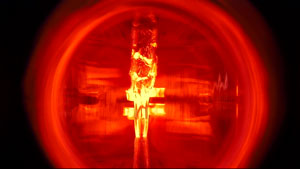Nov. 22, 2019 Research Highlight Physics / Astronomy
Frustrated magnet hosts skyrmions
Skyrmions have been generated in a new class of magnetic materials
 Figure 1: A photograph showing a rod of Gd2PdSi3 crystal being grown by the floating-zone method. © 2019 RIKEN Center for Emergent Matter Science
Figure 1: A photograph showing a rod of Gd2PdSi3 crystal being grown by the floating-zone method. © 2019 RIKEN Center for Emergent Matter Science
Tiny magnetic whirlpools known as skyrmions can be hosted in a new kind of magnetic material where they have not been observed previously, experimental physicists at RIKEN have demonstrated1. This promises to extend the range of materials that can be used for new low-energy devices that employ skyrmion-based information processing.
Conventional computers and mobile devices use electrons to move data and magnetic materials to store it. But this technology is fast approaching its physical limits. Because of this, physicists are searching for new ways to move and store data to advance the computing of the future.
One attractive way to extend data processing and storage is to use skyrmions because they are tiny, highly stable and can be moved using extremely low electric currents. But so far they have only been created in materials that lack a center of symmetry or at interfaces between materials.
“This means that only a limited number of compounds are candidates for skyrmion materials,” explains Takashi Kurumaji of the RIKEN Center for Emergent Matter Science. “Furthermore, skyrmions in such materials tend to be large—generally bigger than 10 nanometers.”
Now, Kurumaji and his co-workers have observed an array of skyrmions in Gd2PdSi3, which is a centrosymmetric material—that is, one with a center of symmetry (Fig. 1). This opens up the range of materials that can be used for hosting skyrmions.
 Takashi Kurumaji and his co-workers have generated a skyrmion lattice in a frustrated triangular-lattice magnet that is centrosymmetric. © 2019 RIKEN
Takashi Kurumaji and his co-workers have generated a skyrmion lattice in a frustrated triangular-lattice magnet that is centrosymmetric. © 2019 RIKEN
“Our results demonstrate that a centrosymmetric material can host skyrmions with diameters down to about 3 nanometers,” says Kurumaji. “This indicates that we can extend the class of candidate materials, raising the possibility of developing compounds that are cheaper, more useful, and easier to make.”
The secret to generating skyrmions in a centrosymmetric material lies in harnessing a different mechanism for stabilizing them. In conventional skyrmion materials, skyrmions are stabilized by a relativistic effect that is quite weak. But in the material that Kurumaji and his co-workers used, skyrmions are stabilized by a different interaction, which arises because the lattice has multiple lowest energy configurations—a property known as magnetic frustration.
Kurumaji and his team picked the material out of a wide range of possible candidates based on previous studies of its electrical and magnetic properties by another group. “When I saw its magnetic phase diagram, I immediately realized that it is quite similar to the theoretically predicted skyrmion phase diagram,” recalls Kurumaji. “These studies provided me with a good starting point.”
Since other kinds of lattices can also exhibit magnetic frustration, the team is planning to see whether they can also host skyrmions.
Related contents
- Material defects hinder the dynamics of magnetic skyrmions
- Sturdy skyrmions stack up
- A skyrmion square dance
Reference
- 1. Kurumaji, T., Nakajima, T., Hirschberger, M., Kikkawa, A., Yamasaki, Y., Sagayama, H., Nakao, H., Taguchi, Y., Arima, T. & Tokura, Y. Skyrmion lattice with a giant topological Hall effect in a frustrated triangular-lattice magnet. Science 365, 914–918 (2019). doi: 10.1126/science.aau0968
